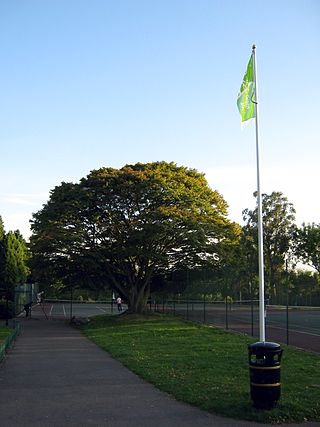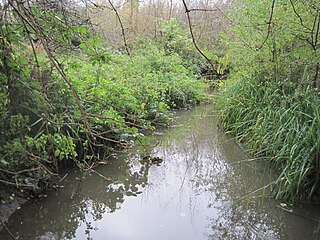Related Research Articles

The Gloucestershire Wildlife Trust is the Gloucestershire local partner in a conservation network of 46 Wildlife Trusts. The Wildlife Trusts are local charities with the specific aim of protecting the United Kingdom's natural heritage. The Gloucestershire Wildlife Trust is managed by a board of trustees elected from its membership who provide overall direction for the development of the trust and there are advisory committees. The work of the trust is carried out through staff and volunteers.

The River Brent is a river in west and northwest London, England, and a tributary of the River Thames. 17.9 miles (28.8 km) in length, it rises in the Borough of Barnet and flows in a generally south-west direction before joining the Tideway stretch of the Thames at Brentford.

Dollis Brook runs through the London Borough of Barnet in north London. It is a tributary of the River Brent, which is itself a tributary of the River Thames. The Dollis Valley Greenwalk follows almost all of Dollis Brook, apart from a short section at the beginning which passes through private land, and the London Loop follows it as far as Barnet Lane. The name Dollis is probably derived from the Middle English word 'dole', meaning the shares of land in the common field.

Coombe Hill Canal lies in the Vale of Gloucester, south west England, north of Leigh and runs west 2.75 miles (4.43 km) from Coombe Hill Basin to the River Severn near Wainlode Hill. It opened in 1796 and closed 80 years later in 1876, after the only lock was damaged by flooding. The Gloucestershire Wildlife Trust purchased the Coombe Hill Canal nature reserve in 1985 and the area is managed by the trust. Adjacent to the Coombe Hill Canal is a large area of wet meadowland situated midway between Gloucester and Tewkesbury to the west of the A38, which was purchased by the trust in 1999. There is a north and a south meadow. This land and the Canal itself often flood in winter, which attracts hundreds of wildfowl.

Folly Brook is a 2+1⁄4-mile (3.6 km) long brook in the London Borough of Barnet. It is a tributary of Dollis Brook, which is a tributary of the River Brent, which is a tributary of the River Thames. Folly Brook is lined for most of its length by narrow strips of woodland and scrub, with a good variety of trees and shrubs. It is one of the best streams in Barnet for small aquatic invertebrates, including several species of caddis fly and a stonefly, which are only found in unpolluted waters.

The River Rom, also known as the River Beam below its confluence with the Ravensbourne, is a tributary of the River Thames in England that flows through east London suburbs surrounding the metropolitan centre of Romford, part of it forming a section of the boundary between the London boroughs of Barking and Dagenham and Havering. The Rom is culverted for a brief midsection as it passes through the centre of Romford.

Hendon Park is a 12 hectare London suburban park situated 7 miles (11 km) north west of Charing Cross. It borders the Northern line, and Hendon Park and Northern line Railway Cutting are a Site of Local Importance for Nature Conservation.
The Greenwich Peninsula Ecology Park is a park situated along the River Thames in the Greenwich Peninsula in South London. The park reflects the nature of the original marshland on the peninsula. The park provides a haven for many different species of bird, plants and bugs and acts as an important brownfield land to control urban sprawl. The park is a partnership project of Homes and Communities Agency (HCA) and now managed by The Conservation Volunteers (TCV). The area of the park is 11 hectares and is half aquatic and half terrestrial. Development was completed in 2000 and the park opened to public in 2002. In April 2011 the Trust took on the management of a new site nearby, the Meantime Nursery, with aims to create on vacant development land a resource for the community and for nature conservation. The park is a Site of Borough Importance for Nature Conservation, Grade I.

Darland's Lake Nature Reserve is a nature reserve south of Totteridge Village in Barnet, England. It is owned by the London Borough of Barnet and was managed from 1971 by the Hertfordshire and Middlesex Wildlife Trust, and more recently by the borough council. In 2007 the council spent £215,000 on repairing the dam and other works, and then proposed leasing the reserve to the Wildlife Trust. The transfer did not take place and in September 2017 a trust was set up by the London Wildlife Trust and local residents associations which took over the management of Darland's Lake. In 2020 Darlands Conservation Trust launched an appeal to raise £450,000 for excavation to prevent the lake drying up.

Rowley Green Common is a six hectare Local Nature Reserve and a Site of Importance Metropolitan for Nature Conservation in Arkley, north London. It is owned by the London Borough of Barnet. It is also registered common land.

Gunnersbury Triangle is a 2.57-hectare (6.4-acre) local nature reserve in Chiswick, in the London boroughs of Ealing and Hounslow, immediately to the east of Gunnersbury. It was created in 1983 when, for the first time in Britain, a public inquiry ruled that a planned development of the land could not go ahead because of its value for nature. It opened as a nature reserve in 1985.

Deans Brook is a two-kilometre-long stream which runs between Mill Hill and Edgware in the London Borough of Barnet. It is a tributary of the Silk Stream, which is a tributary of the River Brent, which is a tributary of the River Thames.

Mill Hill Old Railway Nature Reserve is a 2.3-hectare (5.7-acre) Site of Borough Importance for Nature Conservation, Grade II, in Mill Hill in the London Borough of Barnet.

Mutton Brook is a stream which runs between East Finchley and Hendon in the London Borough of Barnet. It is a tributary of the River Brent, which is itself a tributary of the River Thames.

Clarefield Park is a small park and Site of Local Importance for Nature Conservation in Brent Cross in the London Borough of Barnet.

Burnt Oak Brook is a one-mile-long stream between Mill Hill and Burnt Oak in the London Borough of Barnet. It is a tributary of the Silk Stream, which is a tributary of the River Brent, which is a tributary of the River Thames.

Raeburn Open Space, locally known as Berrylands Nature Reserve, is a 5-hectare Local Nature Reserve and Site of Borough Importance for Nature Conservation, Grade 1, in Berrylands in the Royal Borough of Kingston upon Thames in London, England. It is owned and managed by Kingston Council. but is mainly maintained by local community volunteers. Officially declared a nature reserve in 1992, little was done to manage it as a nature reserve until 2017 when a community initiative began.
References
- 1 2 Yarham, Ian; Game, Meg (2000). Nature conservation in Brent (2nd ed.). London Ecology Unit. ISBN 1-871045-31-2.
- ↑ "Activism for Change". London Wildlife Trust. Retrieved 16 September 2013.
- ↑ Yarham, p. vi
- ↑ Johnston, Jacklyn; Newton, John (1993). "Building Green - A Guide to using plants on roofs, walls and pavements" (PDF). Mayor of London. Archived from the original (PDF) on 16 August 2012. Retrieved 16 September 2013.